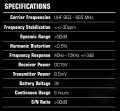I have a pair of UHF wireless microphones running in the 863-865 MHz band. The default antenna length of the receiver is 8 cm (about 1/4 Wavelength). To get better reception I have made a longer antenna extension of about 40-48 cm by taping to the original antenna. I have tried to make some electrical contact, but as the original antenna is painted I am not sure how much electrical contact there is.
I have 2 questions:
1- Can a UHF antenna extension on the receiver work by induction without making electrical contact by concentrating the RF signal? Or will it only work if it makes direct electrical contact with the original receiver antenna?
2- Is the diameter and weight of the metal of the receiver antenna important? Or is only the length important? In other words, will a thicker and heavier antenna be more efficient than a thinner and lighter antenna of the same length?
Your advice would be appreciated
Kind regards
Chris
I have 2 questions:
1- Can a UHF antenna extension on the receiver work by induction without making electrical contact by concentrating the RF signal? Or will it only work if it makes direct electrical contact with the original receiver antenna?
2- Is the diameter and weight of the metal of the receiver antenna important? Or is only the length important? In other words, will a thicker and heavier antenna be more efficient than a thinner and lighter antenna of the same length?
Your advice would be appreciated
Kind regards
Chris









